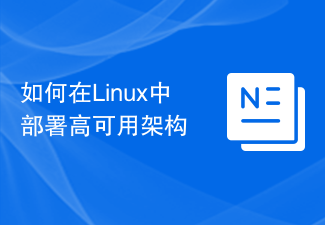 Backend Development
Backend Development PHP Tutorial
PHP Tutorial PHP method to achieve high availability of database containerization
PHP method to achieve high availability of database containerizationWith the rapid development of cloud computing, container technology has made great progress in application deployment and resource management. The database is the core of modern software development, responsible for key business logic and data storage. In order to improve the availability of the database, containerization technology has also been introduced into database deployment.
This article will introduce how to use Docker and Kubernetes to achieve high availability of PHP database containerization.
1. Dockerized MySQL database
Docker is a popular application containerization tool that can easily package applications and their dependencies into Docker images and run them in containers . We can use Docker images to containerize the MySQL database to improve its availability.
- Create a Dockerfile
First, create a file named Dockerfile for building the Docker image. The Dockerfile contains all the instructions needed to build the image, including specifying the base image, adding files, and setting environment variables.
FROM mysql:5.7 ADD my.cnf /etc/mysql/my.cnf ENV MYSQL_ROOT_PASSWORD=root
The FROM instruction specifies the MySQL base image we will use, the ADD instruction adds the my.cnf file to the container, and sets the environment variable MYSQL_ROOT_PASSWORD to root.
- Build Docker image
Use the following command to build the MySQL image:
docker build -t my-mysql .
-t option specifies the image name as my-mysql.
- Run the MySQL container
Next, use the following command to run the MySQL image in the container:
docker run -d --name my-mysql -p 3306:3306
-e MYSQL_ROOT_PASSWORD=root
my-mysqlThe -d option specifies that the container runs in the background, --name specifies the container name as my-mysql, the -p option maps the container internal port 3306 to the host port 3306, and uses environment variables to set the password of the MySQL superuser.
Now, we have successfully containerized MySQL and can access it through localhost:3306.
2. Use Kubernetes to manage MySQL containers
Kubernetes is an open source container orchestration system used to automate the deployment, expansion and management of applications. It provides many useful features such as automatic load balancing, automatic scaling, container storage, etc.
Next, we will use Kubernetes to manage the MySQL container to improve its availability.
- Create a Kubernetes service object
Create a Kubernetes service object that binds all MySQL containers into the same service:
apiVersion: v1
kind: Service
metadata:
name: my-mysql
spec:
ports:
- port: 3306
selector:
app: my-mysqlThis will create A Kubernetes service object named my-mysql listens on port 3306 inside the container.
- Create a Kubernetes deployment object
Create a Kubernetes deployment object, deploy multiple MySQL containers to the same Kubernetes pod, and automatically restart when the container fails:
apiVersion: apps/v1
kind: Deployment
metadata:
name: my-mysql
labels:
app: my-mysql
spec:
replicas: 3
selector:
matchLabels:
app: my-mysql
template:
metadata:
labels:
app: my-mysql
spec:
containers:
- name: mysql
image: my-mysql
ports:
- containerPort: 3306
env:
- name: MYSQL_ROOT_PASSWORD
value: "root"This will create a Kubernetes deployment object named my-mysql containing 3 MySQL containers. If any container fails, Kubernetes will automatically restart it.
Now, we have successfully used Kubernetes to manage the MySQL container and improve its availability.
3. Use PHP to connect to the MySQL container
Finally, we need to use PHP to connect to the MySQL container and perform some simple database operations.
- Create PHP file
Create a PHP file named test.php for connecting to the MySQL container and executing SQL queries:
<?php
$host = "my-mysql.default.svc.cluster.local";
$username = "root";
$password = "root";
$dbname = "test";
$conn = mysqli_connect($host, $username, $password, $dbname);
if (!$conn) {
die("Connection failed: " . mysqli_connect_error());
}
$sql = "SELECT * FROM users";
$result = mysqli_query($conn, $sql);
if (mysqli_num_rows($result) > 0) {
while($row = mysqli_fetch_assoc($result)) {
echo "id: " . $row["id"]. " - Name: " . $row["name"]. "<br>";
}
} else {
echo "0 results";
}
mysqli_close($conn);
?>The The file connects to my-mysql.default.svc.cluster.local, connects to the MySQL container using username and password root, and retrieves data from a table named users.
- Deploy PHP
Upload the test.php file to the web server and start the web server. Now we can access the MySQL container by accessing the web server. For example, if the IP address of the web server is XXX.XXX.XXX.XXX, we can query the MySQL database by accessing http://XXX.XXX.XXX.XXX/test.php.
Conclusion
Containerization technology provides many benefits for modern software development, including application portability, scalability, and maintainability. By using Docker and Kubernetes, we can easily containerize the MySQL database and improve the availability and reliability of the database. If you are developing PHP applications and need to manage MySQL databases, containerization is an essential option.
The above is the detailed content of PHP method to achieve high availability of database containerization. For more information, please follow other related articles on the PHP Chinese website!
 MySQL连接离奇挂死,竟不是连接池的锅……Apr 14, 2023 pm 04:28 PM
MySQL连接离奇挂死,竟不是连接池的锅……Apr 14, 2023 pm 04:28 PM一、背景近期由测试反馈的问题有点多,其中关于系统可靠性测试提出的问题令人感到头疼,一来这类问题有时候属于“偶发”现象,难以在环境上快速复现;二来则是可靠性问题的定位链条有时候变得很长,极端情况下可能要从A服务追踪到Z服务,或者是从应用代码追溯到硬件层面。本次分享的是一次关于MySQL高可用问题的定位过程,其中曲折颇多但问题本身却比较有些代表性,遂将其记录以供参考。1、架构首先,本系统以MySQL作为主要的数据存储部件。整一个是典型的微服务架构(SpringBoot+SpringClou
 使用Go语言构建高可用的消息队列系统Jun 18, 2023 am 09:31 AM
使用Go语言构建高可用的消息队列系统Jun 18, 2023 am 09:31 AM随着在现代化的IT架构中,各种组件之间的通信和协调变得越来越重要。当应用程序需要向其他应用程序或处理器发送消息时,消息队列系统已经成为了重要的设施之一。Go是一种越来越受欢迎的编程语言,它的高效性能和并发性质使其成为开发高可用消息队列系统的理想工具。本文将介绍如何使用Go语言构建高可用的消息队列系统,并探讨实现高可用性的最佳实践。消息队列系统简介在编写一个高
 Go语言中的高可用分布式系统实现策略Jun 30, 2023 pm 05:06 PM
Go语言中的高可用分布式系统实现策略Jun 30, 2023 pm 05:06 PM如何在Go语言开发中实现高可用的分布式系统摘要:随着互联网的快速发展,分布式系统的需求越来越大。如何在Go语言开发中实现高可用的分布式系统成为了一个重要的问题。本文将介绍如何使用Go语言开发高可用的分布式系统。一、介绍分布式系统是由多个独立的节点组成的,节点之间通过网络进行通信和协调。高可用是分布式系统的核心要求之一,它能够保证系统在面对各种异常和故障时仍能
 如何在Linux中部署高可用架构Jun 18, 2023 pm 12:21 PM
如何在Linux中部署高可用架构Jun 18, 2023 pm 12:21 PM随着大数据时代的到来,越来越多的公司和组织开始使用Linux操作系统作为他们的服务器平台。为了保证应用程序的可用性和稳定性,高可用架构已经成为了Linux服务器中不可或缺的一部分。本文将介绍如何在Linux中部署高可用架构。什么是高可用架构?高可用架构(HighAvailability,简称HA)是指在系统出现故障时,依然能够继续提供服务的系统架构。HA可
 如何在Linux上配置高可用的NAT网关Jul 05, 2023 am 11:03 AM
如何在Linux上配置高可用的NAT网关Jul 05, 2023 am 11:03 AM如何在Linux上配置高可用的NAT网关摘要:网络地址转换(NAT)是一种常用的网络技术,用于将私有网络的IP地址转换为公共网络的IP地址。在Linux系统上,配置高可用的NAT网关可以提高网络的可用性和可靠性。本文将介绍如何使用Keepalived和iptables工具,在Linux上配置高可用的NAT网关。关键词:NAT、高可用、Keepalived、i
 Go语言分布式缓存存储系统的高可用性实现Jun 30, 2023 am 11:40 AM
Go语言分布式缓存存储系统的高可用性实现Jun 30, 2023 am 11:40 AM随着互联网的快速发展,对于大规模应用程序的性能需求也越来越高。分布式缓存存储系统是一种常见的解决方案,它可以提高应用程序的性能、可扩展性和可靠性。在本文中,我们将探讨如何在Go语言开发中实现高可用的分布式缓存存储系统。一、背景介绍分布式缓存存储系统是一个面向大规模应用程序的关键基础设施。它通过将数据存储在内存中,加速读取速度,并通过数据复制和数据分片等技术,
 经验技巧:使用Go语言构建高可用的文件服务器Jun 18, 2023 pm 10:24 PM
经验技巧:使用Go语言构建高可用的文件服务器Jun 18, 2023 pm 10:24 PM在现代计算机世界中,文件服务器无疑是一个非常重要的部分。在很多情况下,特别是在企业级应用程序中,文件服务器扮演着存储和处理文件的关键角色。构建高可用的文件服务器是非常关键的,这就意味着确保服务器始终可用并且不会出现数据丢失或损坏的情况。在本文中,我们将讨论使用Go语言构建高可用的文件服务器的经验和技巧。一、选择适当的存储后端选择合适的存储后端是构建高可用文件
 如何使用Golang实现一个高可用的缓存集群?Jun 20, 2023 pm 10:49 PM
如何使用Golang实现一个高可用的缓存集群?Jun 20, 2023 pm 10:49 PM随着互联网应用的快速发展,缓存已成为了很多互联网公司加速访问速度和提高用户体验不可或缺的一部分。为了提高缓存集群的可用性,很多公司选择使用Golang语言来实现一个高可用的缓存集群。本文将介绍如何使用Golang语言实现一个高可用的缓存集群,包括思路,实现方法和优化建议等。一、缓存集群的架构思路采用分布式存储机制为了保证缓存集群的高可用性,我们需要采用分布式


Hot AI Tools

Undresser.AI Undress
AI-powered app for creating realistic nude photos

AI Clothes Remover
Online AI tool for removing clothes from photos.

Undress AI Tool
Undress images for free

Clothoff.io
AI clothes remover

AI Hentai Generator
Generate AI Hentai for free.

Hot Article

Hot Tools

SublimeText3 Mac version
God-level code editing software (SublimeText3)

Dreamweaver Mac version
Visual web development tools

SublimeText3 Chinese version
Chinese version, very easy to use

VSCode Windows 64-bit Download
A free and powerful IDE editor launched by Microsoft

SublimeText3 Linux new version
SublimeText3 Linux latest version





